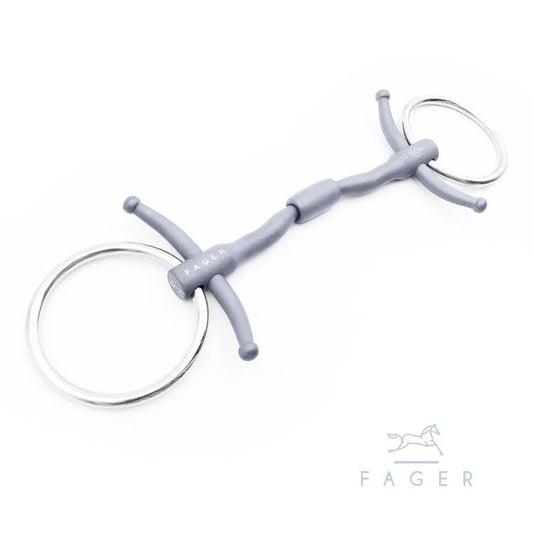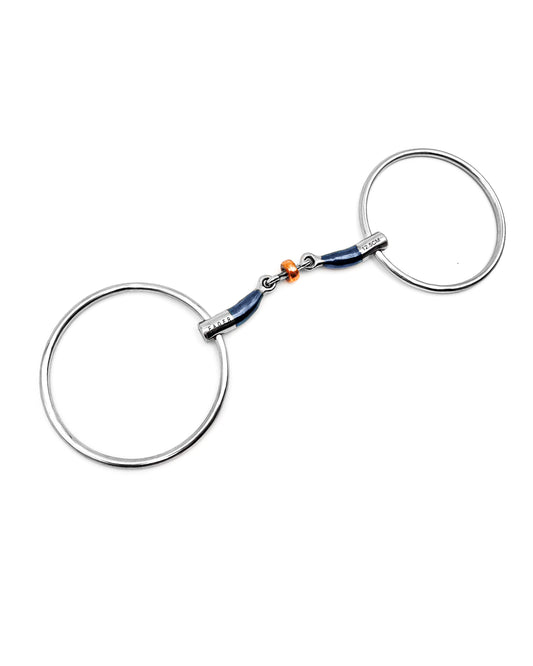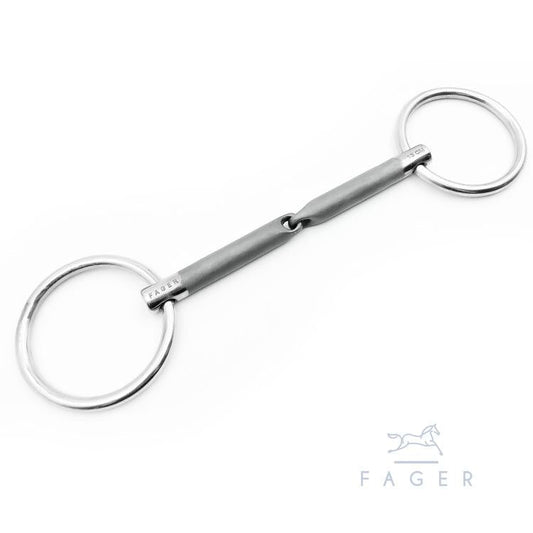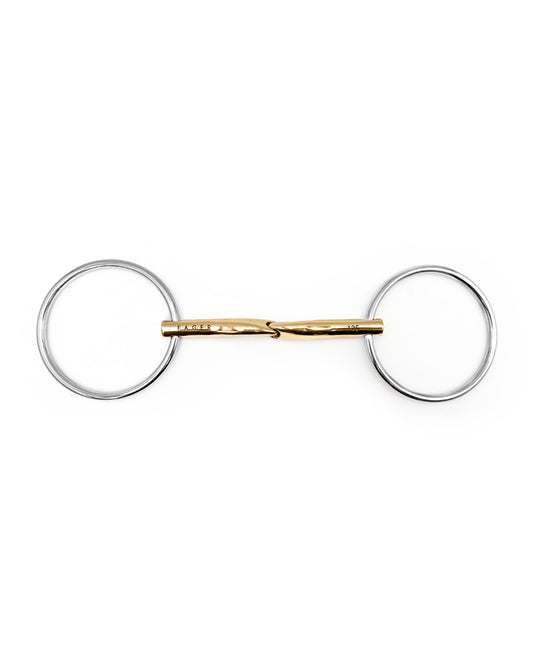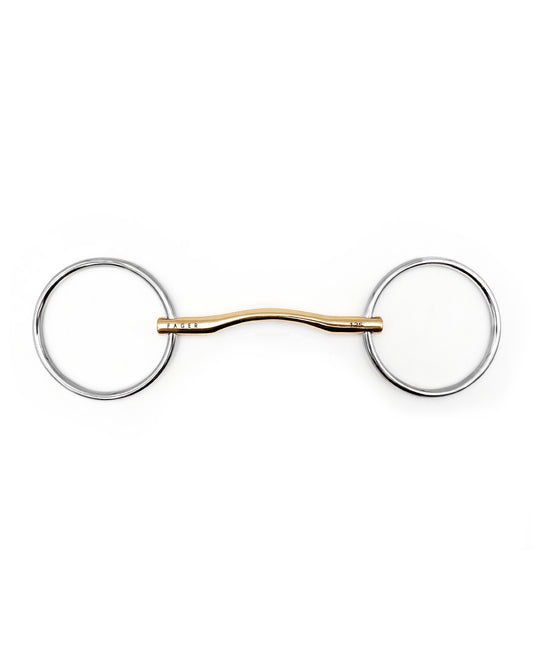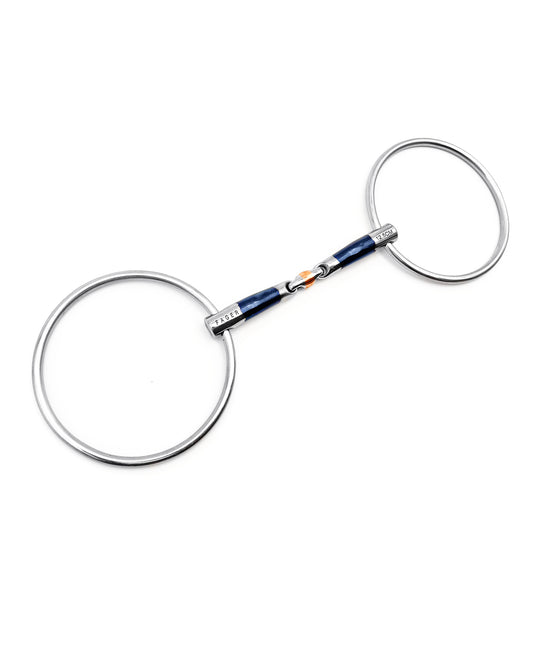Collection: SIDEPIECES GUIDE
LOOSE RINGS


FIXED RINGS


WINGS
Fager Wings have a unique feature called TOL™, Turn Over Lock system prevents the ring from overbending and hit the molars while working your horse. This fantastic feature protects the teeth and makes anxious and tense horses more relaxed.


BABY FULMER
Baby Fulmer is a registered design by Fager. This sidepiece will give you a mix between the loose and fixed rings. The Fulmers will lay close to the horse’s side, helps with steering, and keep the mouthpiece steady. The loose rings are placed further away from the mouth corners, and this will put the pressure further down and inwards, encourage the horse to lift in the front, come back to your hand, and avoid a stiff feeling towards the bit. It is a very comfortable choice for many horses and a great start for a youngster.
Baby Fulmer is FEI approve, even for dressage.


LOOSE BAUCHER
Loose Baucher is a registered design by Fager. This sidepiece is designed to keep the mouthpiece steady, without the loose ring interfering with the mouth piece’s placement.
Loose Baucher is to prefer if you have problems with wounds in the corners of the mouth or wears on the premolars (P2). The Loose Baucher will reveal these places from constant pressure and help the horse to relax.
Loose baucher is FEI approve, even for dressage.


KIMBLEHOOK
The Kimblehook can be described as a fixed ring with the possibility to add leverage when you need it. The further down you place your rein; the more pressure will be added and divided between chin, poll, and mouth. The stable feeling Kimblehook creates can be good for fuzzy and worried horses that gets strong, unbalanced and hard to turn.
The Kimblehook puts the pressure further down in the mouth which can help a horse that gets too high in the neck.
Kimblehooks are always used together with a chain or strap behind the chin.


UNIVERSAL
Universal’s versatility with Baby Fulmer will provide a steady mouthpiece, together with the desirable leverage and flexibility feeling from the Universal rings. The Universal rings work as a Gag-bit when the reins are placed in the lower rings. The ring will glide and put pressure on the neck as well as the mouth. Attach a chain or strap between the top rings that goes behind the chin, and you will divide the pressure on Chin, Poll and mouth. Many different ways to try to find out what your horse prefers.
The Universal rings creates a very flexible and light feeling that can help a horse who gets heavy, stiff, too long and low but still can be sensitive if the bit moves too much in the mouth.


BABY PELHAM
Similar to a Kimblehook, but is used with two reins. It is a combination of a Baucher bit and curb bit in one. The rein placed in the snaffle ring will not add any leverage, and the rein in the bottom ring will. This will give the rider the advantage of adding leverage only when needed.
A Baby pelham can also be used with a converter strap/Pelham roundings between the rings to use only a single rein.


DOUBLE BRIDLE
A Double bridle is a set of two bits, a bradoon, and a Weymouth.
Each of the bits has its own set of reins and can be used separately and combined.
The bradoon (also called bridoon) is used the same way as a snaffle, usually with smaller rings, loose or fixed.
A Bradoon should be placed the same way as your snaffle, close to the mouth corner.
The Weymouth is a curb with a leverage effect and rests slightly lower than the bradoon.
A short shank (5cm) will have an uplifting effect, while a 7cm shank will keep the contact further down.
The Weymouth should be 0,5-1cm bigger than the Bradoon; this will help the upper Cheek bar (also called purchase) to glide more freely.


-
Fager Fanny Titanium Loose Rings
Regular price $220.00 AUDRegular priceUnit price / perFager Fanny Titanium Loose Rings
Regular price $220.00 AUDRegular priceUnit price / per -
Fager Philip Sweet Iron Weymouth
Regular price $280.00 AUDRegular priceUnit price / perFager Philip Sweet Iron Weymouth
Regular price $280.00 AUDRegular priceUnit price / per -
Fager John Sweet Iron Loose Ring
Regular price $195.00 AUDRegular priceUnit price / perFager John Sweet Iron Loose Ring
Regular price $195.00 AUDRegular priceUnit price / per -
Fager Nils Sweet Iron Barrel Baby Fulmer
Regular price $200.00 AUDRegular priceUnit price / perFager Nils Sweet Iron Barrel Baby Fulmer
Regular price $200.00 AUDRegular priceUnit price / per -
Fager Nina Titanium Barrel Baby Fulmer
Regular price $265.00 AUDRegular priceUnit price / perFager Nina Titanium Barrel Baby Fulmer
Regular price $265.00 AUDRegular priceUnit price / per -
Fager Julia Sweet Iron Large Loose Ring
Regular price $205.00 AUDRegular priceUnit price / perFager Julia Sweet Iron Large Loose Ring
Regular price $205.00 AUDRegular priceUnit price / per -
Fager Sally Titanium Fixed Ring
Regular price $255.00 AUDRegular priceUnit price / perFager Sally Titanium Fixed Ring
Regular price $255.00 AUDRegular priceUnit price / per -
Fager Madeleine Titanium Double Jointed Loose Ring
Regular price $255.00 AUDRegular priceUnit price / perFager Madeleine Titanium Double Jointed Loose Ring
Regular price $255.00 AUDRegular priceUnit price / per -
Fager Fredric Titanium Kimblehook
Regular price $340.00 AUDRegular priceUnit price / perFager Fredric Titanium Kimblehook
Regular price $340.00 AUDRegular priceUnit price / per -
Fager Elisabeth Titanium Weymouth
Regular price $360.00 AUDRegular priceUnit price / perFager Elisabeth Titanium Weymouth
Regular price $360.00 AUDRegular priceUnit price / per -
Fager Sofia Titanium Weymouth
Regular price $360.00 AUDRegular priceUnit price / perFager Sofia Titanium Weymouth
Regular price $360.00 AUDRegular priceUnit price / per -
Fager Kasper Sweet Iron Bradoon Loose Ring
Regular price $195.00 AUDRegular priceUnit price / perFager Kasper Sweet Iron Bradoon Loose Ring
Regular price $195.00 AUDRegular priceUnit price / per -
Fager Erik Sweet Iron Weymouth
Regular price $260.00 AUDRegular priceUnit price / perFager Erik Sweet Iron Weymouth
Regular price $260.00 AUDRegular priceUnit price / per -
Fager Felicia Titanium Weymouth
Regular price $320.00 AUDRegular priceUnit price / perFager Felicia Titanium Weymouth
Regular price $320.00 AUDRegular priceUnit price / per -
Fager Madeleine Titanium Single Joint Bradoon Loose Ring
Regular price $255.00 AUDRegular priceUnit price / perFager Madeleine Titanium Single Joint Bradoon Loose Ring
Regular price $255.00 AUDRegular priceUnit price / per -
Fager Carina Sweet Gold Large Loose Ring
Regular price $265.00 AUDRegular priceUnit price / perFager Carina Sweet Gold Large Loose Ring
Regular price $265.00 AUDRegular priceUnit price / per -
Fager Valerie Sweet Gold Large Loose Ring
Regular price $265.00 AUDRegular priceUnit price / perFager Valerie Sweet Gold Large Loose Ring
Regular price $265.00 AUDRegular priceUnit price / per -
Fager John Sweet Iron Large Loose Ring
Regular price $205.00 AUDRegular priceUnit price / perFager John Sweet Iron Large Loose Ring
Regular price $205.00 AUDRegular priceUnit price / per -
Fager Maria Titanium Large Loose Ring
Regular price $265.00 AUDRegular priceUnit price / perFager Maria Titanium Large Loose Ring
Regular price $265.00 AUDRegular priceUnit price / per -
Fager Fanny Titanium Fixed Rings
Regular price $220.00 AUDRegular priceUnit price / perFager Fanny Titanium Fixed Rings
Regular price $220.00 AUDRegular priceUnit price / per



